
The Viking Serpent: Serpent Worship, Sacred Geometry, and Secrets of the Celtic Church in Norway
Dan Brown wrote The Da Vinci Code, inspired by Henry Lincoln and his two co-authors’ The Holy Blood and the Holy Grail. The Norwegian researcher Harald Boehlke was inspired by the same book. Lincoln’s tantalizing bait was religion and sacred geometry—specially the sacred pentagram.
In the opening scene of The Da Vinci Code, Dan Brown featured a dying man who had inscribed a pentagram onto his stomach with his own blood. Religion, Sacred geometry, and suspense were the ingredients that kept audiences spellbound. But, it was mainly fiction.
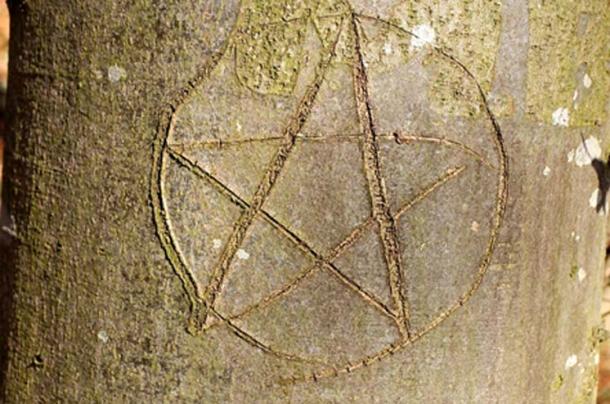
A pentagram image was found on the body. (Public Domain)
What Harald found, however, is not fiction. In researching Norway’s Viking history, and Norway’s conversion to Christianity, he was led to profound discoveries. These surpassed by far even the astonishing geometry discovered on the blood-soaked soil of the Languedoc area of southern France, where the gnostic Cathars had been killed by the thousands by the Catholic Church and The Templars had many of their strongholds.
A completely different story regarding Norway’s conversion was revealed, rather than the hitherto accepted one. Harald discovered what is now called The Norwegian Pentagram, and other enormous geometric patterns with symbolic measurements, constructed with the help of cities built during the conversion years (ca.900-1130) to act as markers. And lo and behold, it was seen that Norway had not been converted by the Roman Catholics as had always been the accepted story.
Astonishing Discovery of Sacred Geometry and Ancient Symbols
The pentagram is for many a mysterious, foreboding, fateful and intimidating symbol. The Catholic Church must take credit for turning the pentagram from a symbol of the sacred feminine to a symbol of the devil. But the pentacle's demonic interpretation is historically inaccurate.
It has had many meanings in many cultures, tracing back in time many thousand years. The use of 1.618, called the Golden Section, or Golden Mean in sacred architecture is prevalent throughout Europe.
Pythagoreans considered the pentagram an emblem of perfection or the symbol of the human being. In a way, you might say it is the fingerprint of God. The pentagram incorporates the Golden Section 1.168. It is constructed using this number, and this number only. It can be said the pentagram is the visualization of the Golden Section 1.618.
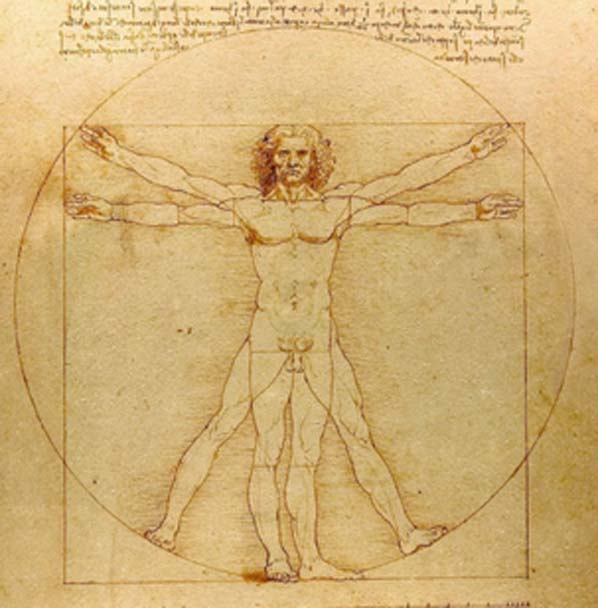
The REAL Da Vinci Code: Vitruvian Man. The proportional relationship of the parts reflects universal design. (Public Domain)
This number is a large part of Holy Geometry. It permeates creation; It defines the spirals of a Nautilus shell, snowflakes, the galaxies, honeycombs. It is in many ways the number of creation as it is also mirrored in the proportions of the human body.
After Harald’s discovery of the ‘Norwegian Pentagram’ – enormous geometric patterns with symbolic measurements, and ancient spiritual sites in Norway creating a pentagram across the landscape— a larger mystery now confronted him: who had placed this sacred geometry across the whole of southern Norway?
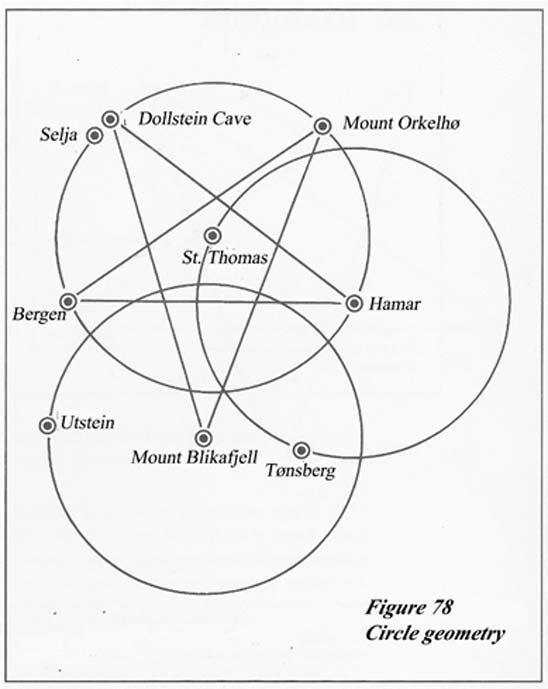
Norwegian Pentagram (From The Viking Serpent by Harald S Boehlke)
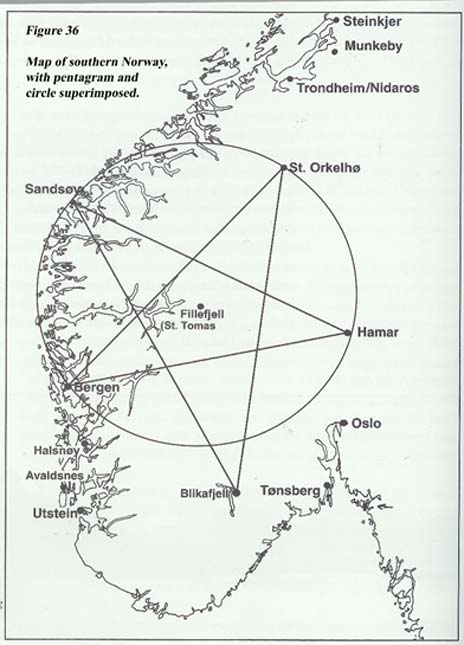
Who may have created a symbolic pentagram in Norway? (From The Viking Serpent by Harald S Boehlke)
The sacred geometry was not limited to the pentagram. Studying the Sagas and other historical works led him to discover more geometry. Strange myths and fables that he had dismissed earlier suddenly seemed to make sense, leading to one exciting discovery after the other. The books The Norwegian Pentagram and its English translation The Viking Serpent came into being.
Startling History: Celts brought Christianity to Norway?
The research showed that the Celts brought Christianity to Norway, a fact that at best has been played down in our time of ‘enlightenment’. The important part the Celts played in the unification and christening of Norway has been hidden behind a veil pulled down by the Roman Catholic Church as they maneuvered into position within Norway, as in the rest of Europe.
In the year 1000 CE, Norway was still a ‘heathen’ country, and contrary to popular belief, it was not the Roman Catholic Church that had struggled to convert the feared Vikings to Christianity. Abundant evidence was found that suggested certain groupings within the Celtic Church had converted the Vikings to Christendom instead. These were Gnostics from the Celtic Church, influenced by the serpent worshipping Ophites from Egypt and Syria who used the serpent as a symbol of Christ.
After Emperor Constantine in 325CE sanctioned the Christian faith which believed Jesus being the son of god, the Gnostics, Arians, Ophites and other sects were persecuted and dispersed. The persecution of the Gnostics was mainly the work of the influential group that later evolved into what we today call the Roman Catholic Church.
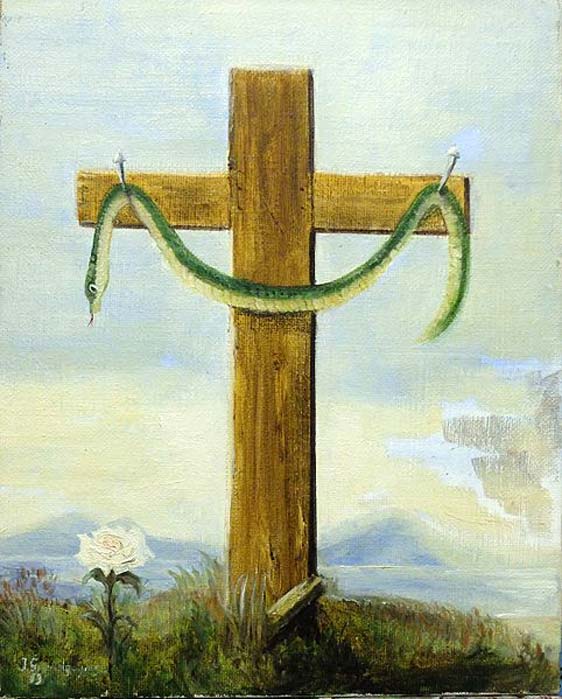
The Serpent on the Cross - The Crucified Serpent, after an illustration in the notebook of Nicolas Flamel (CC BY-SA 4.0)
From the Middle East, the ideas and beliefs of the Gnostic Arians and Ophites disseminated towards the ‘outskirts’ of Europe. The Arians went as far north as the Iberian Peninsula, while the Ophites apparently found their way to the British Isles where, according to legend, St. Patrick was sent to Ireland to ‘guide’ the Celts back to the ‘true faith’. While there, he took time to banish all “serpents” from Ireland some time during the fifth century, apparently without too much success. It is interesting to note that there have never been serpents in Ireland. Patrick’s feat is therefore all the more interesting. The ‘serpents’ he attempted to banish were probably bipedal – those of the Celtic Church who revered the ‘serpent’ Jesus.
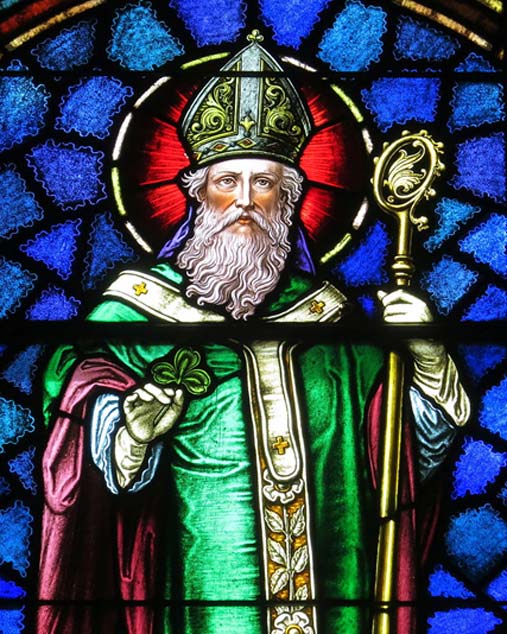
Stained glass window featuring St Patrick (CC BY-SA 4.0)
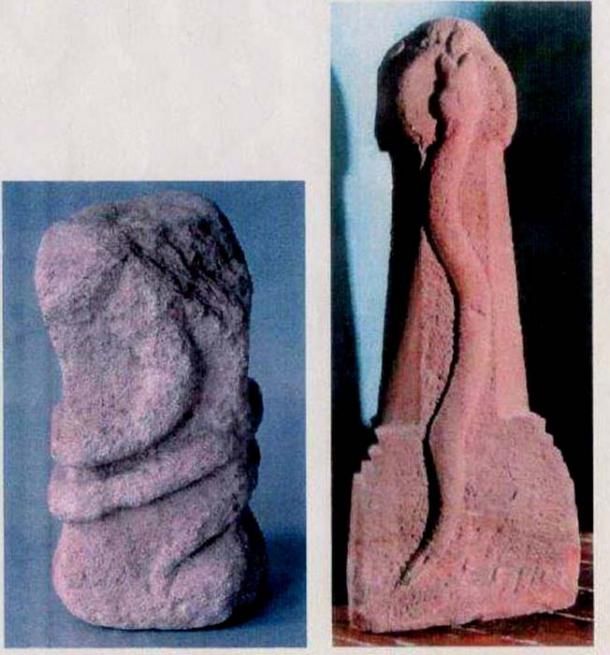
The ‘snakes’ that St Patrick drove out of Ireland were the Druidic priests who had serpents tattooed on their forearms. Serpent altars from Cornwall England and from Senhouse Museum, Maryport, Cumbria, England. (Source: Harald Boehlke)
Secret Arrangements, Religion and Kingmaking
From the ninth century, Norwegian Vikings had settled in the Celtic fringe of the British Isles. From the Orkneys in the north down through Northumberland, Cumbria and Wales as well as areas in Ireland, they made new lives for themselves, mainly as farmers and artisans (a fact that did not exclude the occasional ‘Viking raid’).
- The conspiracy theories of Bérenger Saunière and Rennes-le-Château
- What Ancient Secrets Lie Within the Flower of Life?
- The Mysterious Connection Between Geophysics, Architecture and Biomedicine
- Ancient Pueblo Peoples Practiced Advanced Geometry without a Known Written Language or Numerical System, Could You?
The heathen Norwegians came into contact with the Gnostic Celtic Church, who from 935-1015 CE, made secret arrangements and engaged in a joint venture with no fewer than three Vikings of royal descent intent upon ascending the Norwegian throne. The Viking kings-to-be made plans to unite Norway as one kingdom, with themselves on the throne. In return for Celtic monetary and administrative aid the Viking kings gave them ‘permission’ to pursue their own ambitions: to convert the Asatru pagans (ancient Norse religion) to Celtic Christianity. The Celtic Church was intent on using Christian magic to consecrate and conquer the land and its people, inaugurating one king and one religion. They traded their knowledge of how to pacify a rebellious population by introducing religion, piousness, and ecclesiastical laws enabling their Viking mentors to ascend the throne, and keep it.
The Celts first made contact with the son of the Norwegian Viking-king Harald ‘Fairhair’, the young Haakon. During the first half of the 10th Century, Haakon was brought up at the court of the Wessex king Athelstan.
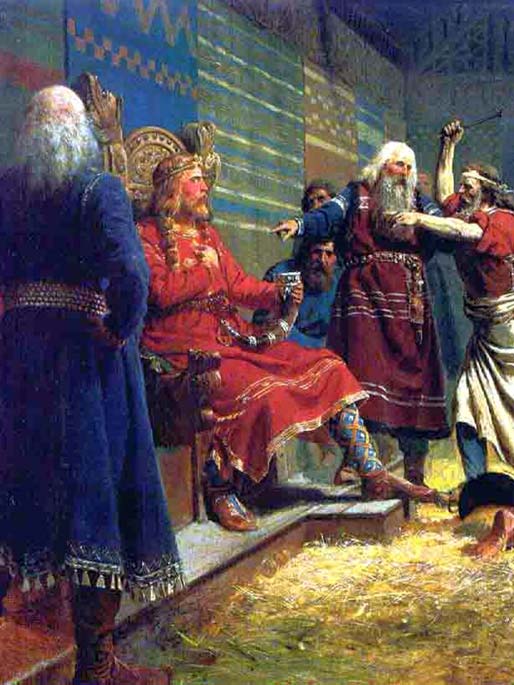
Haakon ‘The Good’, son of Harald Fairhair (Public Domain)
Monks from the monastery at Glastonbury had given Haakon his education, and upon the death of his father, Haakon returned to Norway with his Celtic helpers, conquered the throne, and began an enormous secret undertaking which was not to be revealed for a thousand years.
After the death of Haakon (ca. 961 CE), the Celtic clergy cooperated with the famed Viking king-to-be, Olav Tryggvason and later with Olav the Holy. These three constitute the most renowned of the Norwegian Viking rulers.
Sacred Symbols, 666, and the Golden Ratio
When the Celts arrived in Norway, they founded cities and monasteries as sacred markers. They and their Viking collaborators removed old cities that did not fit into the sacred pattern—a pattern that resulted in a gigantic pentagram stretching across southern Norway.
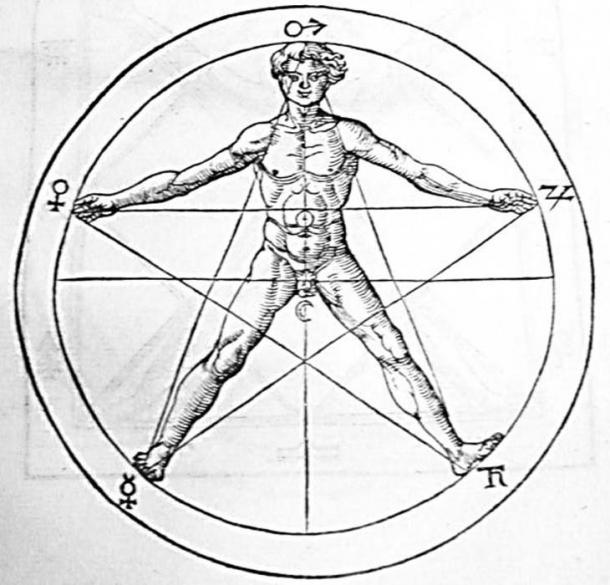
The drawing of a man's body in a pentagram suggests relationships to the golden ratio. By Heinrich Cornelius Agrippa, circa 1510. (Public Domain)
It was invisible unless one knew how to utilize the holy mathematical formulae of ‘The Golden Ratio’. Only the initiated knew it was there, and only the initiated could trace it using the monasteries and the five medieval cities of Norway: Nidaros, Tunsberg, Bergen, Stavanger and Hamar.
In The Viking Serpent, Harald demonstrates how they were all laid down according to the ‘Golden Ratio’.
Norway’s two round churches mark the two extremities of the main geometric marker line. The resulting pentagram is inscribed in a circle measuring 666 miles in circumference - the number of the Beast symbolizing Christ as the serpent, as shown in the Gnostic Nag Hammadi texts found in the Egyptian desert in 1945.
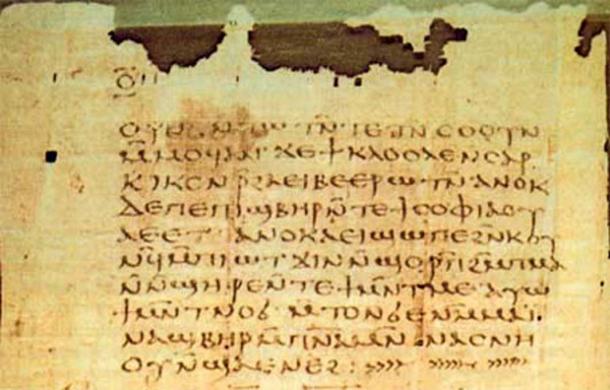
The Apocalypse of Peter: Gnostic Nag Hammadi text, circa 100 and circa 200 AD (Public Domain)
These texts describe Jesus as the one “called the Beast” (From the Nag Hammadi Library: The interpretation of “the beast” is “the instructor.” For it was found to be the “wisest of all beings.”) Thus, the Celts introduced their Christianity to Norway, leaving behind a trail of serpent imagery. The Celtic clergy’s use of the ‘Number of the Beast’ reflects their occult use of ‘magic’ and their reverence of the serpent.
- Viracocha's Astronomical Creation Engine
- A Monstrous and Venomous Serpent: Legendary Crusading Heroes and Wyrm-Slaying Symbolism – What Does it Mean?
- Tracing the origins of the Serpent Cult
Serpents Abound
The saga writer Snorre Sturluson noted that king Olav (the third ally of the Celtic Church), on his return to Norway from the British Isles in 1015 CE, used the serpent as a symbol on his helmet and banner. In an old saga of which only fragments remain, the burial of St. Olav also reflects the number 666. The stave churches, unique to Norway, were built during these times.
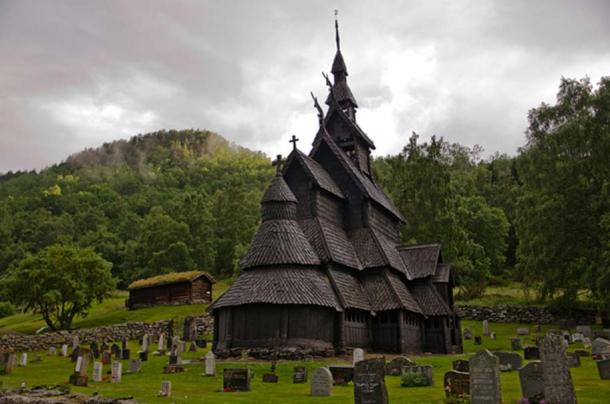
Borgund Stave Church, Laerdal, Sogn og Fjordane County, Western Norway (CC BY-SA 3.0)
These churches were decorated with serpent imagery in abundance: woodcarvings of writhing coiling snakes climbing the portals, and from all gables one can witness – even today – serpents raising their heads with playing tongues.
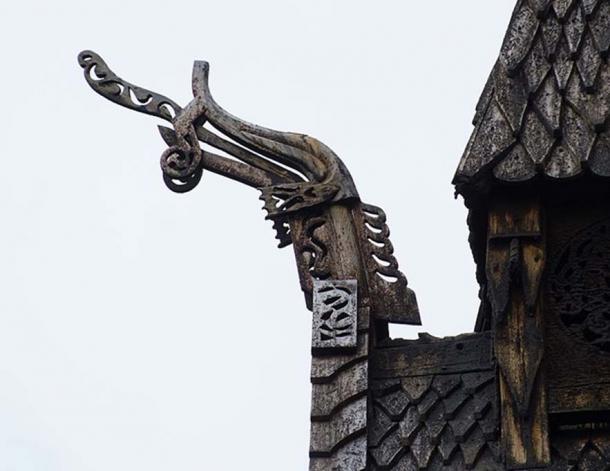
Borgund Stave Church with wooden serpent architecture (CC BY-SA 4.0)
Additionally, the roofs and walls of these churches are covered with wooden ‘scales’ that seem to mimic serpent-skin.
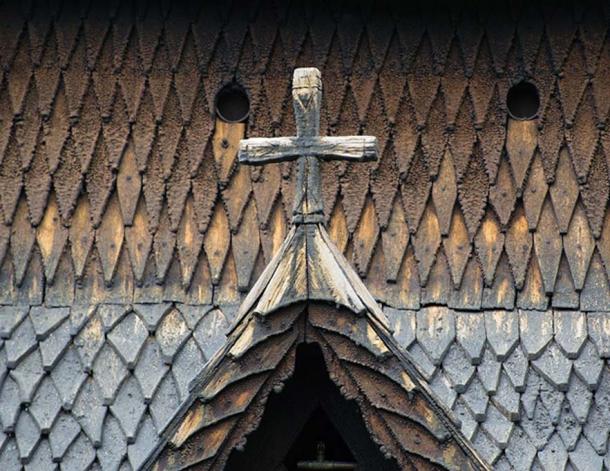
Borgund Stave Church clad with what looks like scales (CC BY-SA 4.0)
Another of the many interesting facts regarding Celtic influences is that the coastline of Norway boasts numerous large Celtic stone crosses. Norway is the only other country besides the ‘Celtic fringe’ on the British Isles that has such crosses.
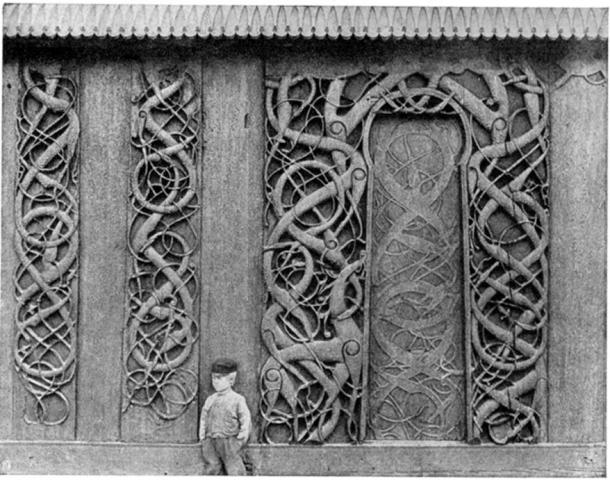
Serpent carvings adorning the church portal (Kind permission from Norwegian Directorate of Cultural Heritage)
Folklore Reveals Ancient Connections
Interesting too is the story of a Celtic princess, Sunniva, escaping barbaric ‘suitors’ by setting to sea in a frail Celtic wicker-and-hide craft. According to lore, she landed with her entourage on a small island on the fiercest part of the Norwegian coast and became Norway’s very first saint.
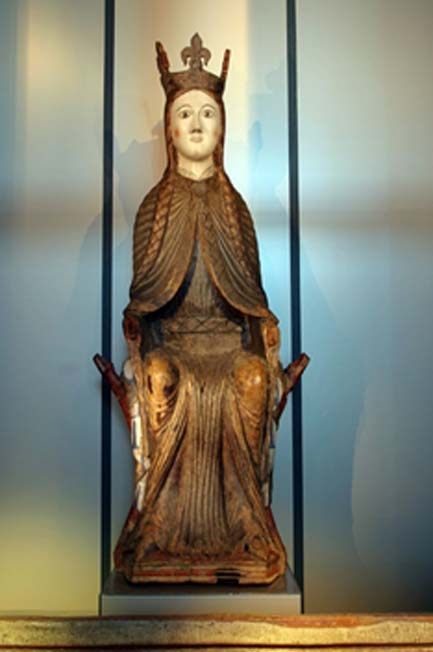
Medieval statue (dated c. 1200) Found in Urnes stave church, Luster, Western Norway, which may be St Sunniva. (CC BY-SA 2.0)
On this same tiny inhospitable island on the fiercest stretch of the Norwegian coast, Norway’s first bishopric was erected in 1068 CE. In 997CE, the Celtic clergy and their second ally the Viking King Olav Tryggvason, founded the city of Nidaros, which was the capital of Norway for hundreds of years. It is interesting to note that Nidaros can be translated into the Gaelic language as meaning “old serpent wisdom”, ‘Neidr’ being serpent, and ‘ros’ being old knowledge.
The sacred geometry of Norway does not limit itself to the enormous pentagram: According to old legends, a certain Norwegian island called Sandøy, or ‘Sandy Island’ is connected to Scotland under the sea. It just so happens that the northwestern upper point of the enormous pentagram falls upon a small island called Sandsøy, or ‘Sandy Island’. On this island, facing the sea, we find the Dollstein cave, which has an intriguing history. Myths tell of treasures hidden in the cave, sought by the Orkney earl Ragnvald in 1127. Even myths about King Arthur are weaved into the island’s lore!
The sacred geometry in the landscape of Norway is so ingeniously contrived, it is difficult for us to understand how it was done. Certainly, the builders’ skills of surveying far surpassed anything historians have been willing to give them credit for. The Norwegian Pentagram and the Viking Serpent will undoubtedly prove to be important additions to our understanding of our forefathers’ skills and beliefs, as well as lifting the veil that the Christian church, historians and archaeologists have lowered over our eyes.
Harald S. Boehlke was born into a Norwegian diplomat family in Oslo, Norway in 1946, and has lived in five different countries. His main interests lie in archaeology, history and art—and shining a bright light on hidden mysteries. Harald is author of The Viking Serpent. | Visit TheVikingSerpent.com
--
Top Image: Borgund Stave Church (Eduardo/CC BY-SA 2.0), pentagram, Vitruvian man, and serpent (Public Domain); Deriv.
















Comments
I find it hard to believe that the Irish church was gnostic. The Irish church was a creation of St Patrick and he was certainly not gnostic, his demonstration of the Trinity using a clover leaf is well known. And he converted Ireland some centuries before the Vikings.
Thank you so for this scholarly article and my learning of the snake connection to Jesus. The Egyptians equated snake as teacher. In my view The Caduceus is the male and female serpents as teachers - the mirror of the other to attain equality - wholeness. I am of Icelandic origin. I too have hung on the tree of life as did Odin and sacrificed an eye (now healed -have vision) to learn the secrets of the Tree, Runes,pentagram,sacred geometry - Phi and Pi & more. We are meant to be walking trees. The pentagram is another symbol of the cross -the five elements. Do you think every Nation has the pentagram also inscribed? .
Can you tell me its meaning?
A scrambled and confusing article. Little snippets of information, not well connected. The article does not offer that which the heading suggests.
The Pentagram originates from the apparent movement of Venus against the background sky.
The article should describe the points of the Pentagram depicting the Golden mean as not many know of the Golden Mean embedded within.
The snake is a an ancient symbol of wisdom and predates Christianity, by possibly, thousands of years.
The 'Celtic Cross" is a hand held mechanical instrument to find longitude (prior to the invention of the chronometer). It was subsequently cast in stone and placed over the grave to enable the interred a facility to find their way on the journey after death. Want more information? guillaume at icon.co.za